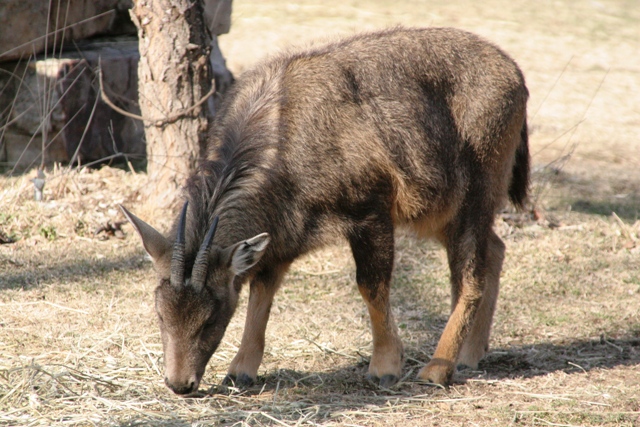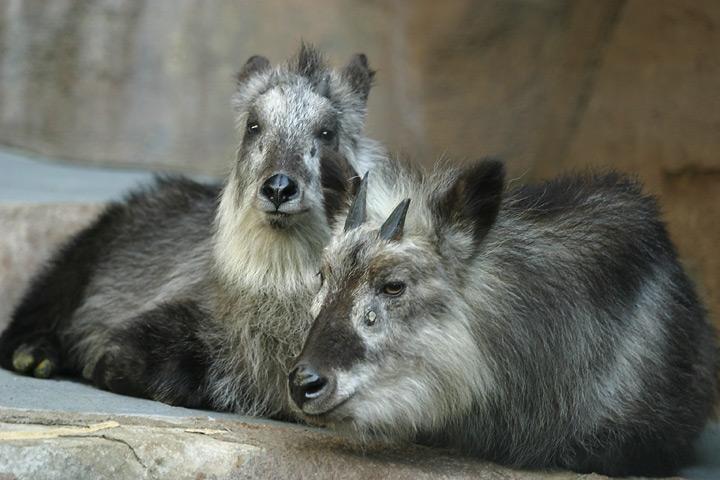|
Serow
The serows ( or ) are four species of medium-sized goat-like or antelope-like mammals of the genus ''Capricornis''. All four species of serow were until recently also classified under '' Naemorhedus'', which now only contains the gorals. Extant species This genus has been studied and organized a number of times. In 2005, Mammal Species of the World 3rd ed. listed six different species (''C. crispus'', ''C. milneedwardsii'', ''C. rubidus'', ''C. sumatraensis'', ''C. swinhoei'', and ''C. thar''), with two subspecies of ''C. milneedwardsii''. The current consensus are the following four species, with ''milneedwardsii'' and ''thar'' demoted to subspecies of ''C. sumatraensis'': Serows live in central and eastern Asia. Their coloration varies by species, region, and individual. Both sexes have beards and small horns which are often shorter than their ears. Like their smaller relatives the gorals, serows are often found grazing on rocky hills, though typically at a lower elevation w ... [...More Info...] [...Related Items...] OR: [Wikipedia] [Google] [Baidu] |
Capricornis Crispus
The : (''Capricornis crispus'') ( 羚羊) is a Japanese goat-antelope, an even-toed ungulate mammal. It is found in dense woodland in Japan, primarily in northern and central Honshu. The serow is seen as a national symbol of Japan, and is subject to protection in conservation areas. Adult Japanese serow stand about tall and weigh . They are black to whitish, and colouring lightens in summer. The fur is very bushy, especially the tail. Both sexes have short, backwards-curving horns, and are difficult to distinguish by sight. Japanese serow are found in dense mountain forests where they eat leaves, shoots, and acorns. They are diurnal and feed in early mornings and late afternoons. Serows are solitary, or gather in couples or small family groups. The animal marks its territory with sweet-and-sour-smelling preorbital gland secretions, and males and females have separate territories that may overlap. In the mid-20th century, the Japanese serow was hunted to near-extinction. In ... [...More Info...] [...Related Items...] OR: [Wikipedia] [Google] [Baidu] |
Japanese Serow
The : (''Capricornis crispus'') ( 羚羊) is a Japanese goat-antelope, an even-toed ungulate mammal. It is found in dense woodland in Japan, primarily in northern and central Honshu. The serow is seen as a national symbol of Japan, and is subject to protection in conservation areas. Adult Japanese serow stand about tall and weigh . They are black to whitish, and colouring lightens in summer. The fur is very bushy, especially the tail. Both sexes have short, backwards-curving horns, and are difficult to distinguish by sight. Japanese serow are found in dense mountain forests where they eat leaves, shoots, and acorns. They are diurnal and feed in early mornings and late afternoons. Serows are solitary, or gather in couples or small family groups. The animal marks its territory with sweet-and-sour-smelling preorbital gland secretions, and males and females have separate territories that may overlap. In the mid-20th century, the Japanese serow was hunted to near-extinction. In ... [...More Info...] [...Related Items...] OR: [Wikipedia] [Google] [Baidu] |
Mainland Serow
The mainland serow (''Capricornis sumatraensis'') is a serow species native to the Himalayas, Southeast Asia and China. The mainland serow is related closely to the red serow, Himalayan serow, Sumatran serow, and the Chinese serow (''C. milneedwardsii)''. Taxonomy In 1831, Brian Houghton Hodgson first described a goat-like animal with short annulated horns occurring in montane regions between the Sutlej and Teesta Rivers under the name "Bubaline Antelope". As "Bubaline" was preoccupied, he gave it the scientific name ''Antelope thar'' a few months later. When William Ogilby described the genus '' Capricornis'' in 1838, he determined the Himalayan serow as type species of this genus. Teeth from ''C. sumatraensis'' were found in a dig from Khok Sung, estimated to originate from the Middle Pleistocene. Characteristics The mainland serow possesses guard hairs on its coat that are bristly or coarse and cover the layer of fur closest to its skin to varying degrees. The animal ... [...More Info...] [...Related Items...] OR: [Wikipedia] [Google] [Baidu] |
Capricornis Sumatraensis
The mainland serow (''Capricornis sumatraensis'') is a serow species native to the Himalayas, Southeast Asia and China. The mainland serow is related closely to the red serow, Himalayan serow, Sumatran serow, and the Chinese serow (''C. milneedwardsii)''. Taxonomy In 1831, Brian Houghton Hodgson first described a goat-like animal with short annulated horns occurring in montane regions between the Sutlej and Teesta Rivers under the name "Bubaline Antelope". As "Bubaline" was preoccupied, he gave it the scientific name ''Antelope thar'' a few months later. When William Ogilby described the genus '' Capricornis'' in 1838, he determined the Himalayan serow as type species of this genus. Teeth from ''C. sumatraensis'' were found in a dig from Khok Sung, estimated to originate from the Middle Pleistocene. Characteristics The mainland serow possesses guard hairs on its coat that are bristly or coarse and cover the layer of fur closest to its skin to varying degrees. The animal ... [...More Info...] [...Related Items...] OR: [Wikipedia] [Google] [Baidu] |
Serow Capricornis Sumatraensis
The serows ( or ) are four species of medium-sized goat-like or antelope-like mammals of the genus ''Capricornis''. All four species of serow were until recently also classified under '' Naemorhedus'', which now only contains the gorals. Extant species This genus has been studied and organized a number of times. In 2005, Mammal Species of the World 3rd ed. listed six different species (''C. crispus'', ''C. milneedwardsii'', ''C. rubidus'', ''C. sumatraensis'', ''C. swinhoei'', and ''C. thar''), with two subspecies of ''C. milneedwardsii''. The current consensus are the following four species, with ''milneedwardsii'' and ''thar'' demoted to subspecies of ''C. sumatraensis'': Serows live in central and eastern Asia. Their coloration varies by species, region, and individual. Both sexes have beards and small horns which are often shorter than their ears. Like their smaller relatives the gorals, serows are often found grazing on rocky hills, though typically at a lower elevation w ... [...More Info...] [...Related Items...] OR: [Wikipedia] [Google] [Baidu] |
Capricornis Rubidus
{{eventoedungulate-stub ...
The red serow (''Capricornis rubidus''), also called the Burmese red serow is a goat-antelope thought to be native to southern Bangladesh and northern Myanmar. It has been sometimes been considered a subspecies of '' C. sumatraensis''. In the northeastern part of India, the red serow occurs widely in the hills south of the Brahmaputra river. although the IUCN states that this species is recorded with certainty only from Myanmar, in Kachin State, and that records in India refer to the Himalayan serow. References red serow Mammals of Bangladesh Mammals of Myanmar red serow The red serow (''Capricornis rubidus''), also called the Burmese red serow is a goat-antelope thought to be native to southern Bangladesh and northern Myanmar. It has been sometimes been considered a subspecies of '' C. sumatraensis''. In the nor ... [...More Info...] [...Related Items...] OR: [Wikipedia] [Google] [Baidu] |
Red Serow
{{eventoedungulate-stub ...
The red serow (''Capricornis rubidus''), also called the Burmese red serow is a goat-antelope thought to be native to southern Bangladesh and northern Myanmar. It has been sometimes been considered a subspecies of '' C. sumatraensis''. In the northeastern part of India, the red serow occurs widely in the hills south of the Brahmaputra river. although the IUCN states that this species is recorded with certainty only from Myanmar, in Kachin State, and that records in India refer to the Himalayan serow. References red serow Mammals of Bangladesh Mammals of Myanmar red serow The red serow (''Capricornis rubidus''), also called the Burmese red serow is a goat-antelope thought to be native to southern Bangladesh and northern Myanmar. It has been sometimes been considered a subspecies of '' C. sumatraensis''. In the nor ... [...More Info...] [...Related Items...] OR: [Wikipedia] [Google] [Baidu] |
Caprinae
The subfamily Caprinae, also sometimes referred to as the tribe Caprini, is part of the ruminant family Bovidae, and consists of mostly medium-sized bovids. A member of this subfamily is called a caprine, or, more informally, a goat-antelope (although they are not considered antelopes). Within this tribe, a prominent clade includes sheep and goats. Some earlier taxonomies considered Caprinae a separate family called Capridae (with the members being caprids), but now it is usually considered either a subfamily within the Bovidae, or a tribe within the subfamily Antilopinae of the family Bovidae, with caprines being a type of bovid. Characteristics Although most goat-antelopes are gregarious and have fairly stocky builds, they diverge in many other ways – the muskox (''Ovibos moschatus'') is adapted to the extreme cold of the tundra; the mountain goat (''Oreamnos americanus'') of North America is specialised for very rugged terrain; the urial (''Ovis orientalis'') occup ... [...More Info...] [...Related Items...] OR: [Wikipedia] [Google] [Baidu] |
Goral
The gorals are four species in the genus ''Naemorhedus''. They are small ungulates with a goat-like or antelope-like appearance. Until recently, this genus also contained the serow species (now in genus '' Capricornis''). Etymology The original name is based on Latin ''nemor-haedus'', from ''nemus, nemoris'' 'grove' and ''haedus'' 'little goat', but it was misspelt ''Naemorhedus'' by Hamilton Smith (1827). of International Commission on Zoological Nomenclature reads: "If there is in the original publication itself, without recourse to any external source of information, clear evidence of an inadvertent error, such as a lapsus calami or a copyist's or printer's error, it must be corrected." The name "goral" comes from an eastern Indian word for the |
Goral
The gorals are four species in the genus ''Naemorhedus''. They are small ungulates with a goat-like or antelope-like appearance. Until recently, this genus also contained the serow species (now in genus '' Capricornis''). Etymology The original name is based on Latin ''nemor-haedus'', from ''nemus, nemoris'' 'grove' and ''haedus'' 'little goat', but it was misspelt ''Naemorhedus'' by Hamilton Smith (1827). of International Commission on Zoological Nomenclature reads: "If there is in the original publication itself, without recourse to any external source of information, clear evidence of an inadvertent error, such as a lapsus calami or a copyist's or printer's error, it must be corrected." The name "goral" comes from an eastern Indian word for the |
Preorbital Gland
The preorbital gland is a paired exocrine gland found in many species of hoofed animals, which is homologous to the lacrimal gland found in humans. These glands are trenchlike slits of dark blue to black, nearly bare skin extending from the medial canthus of each eye. They are lined by a combination of sebaceous and sudoriferous glands, and they produce secretions which contain pheromones and other semiochemical compounds. Ungulates frequently deposit these secretions on twigs and grass as a means of communication with other animals. The preorbital gland serves different roles in different species. Pheromone-containing secretions from the preorbital gland may serve to establish an animal's dominance (especially in preparation for breeding), mark its territory, or simply to produce a pleasurable sensation to the animal. Because of its critical role in scent marking, the preorbital gland is usually considered as a type of scent gland. A further function of these glands may be ... [...More Info...] [...Related Items...] OR: [Wikipedia] [Google] [Baidu] |




.jpg)
